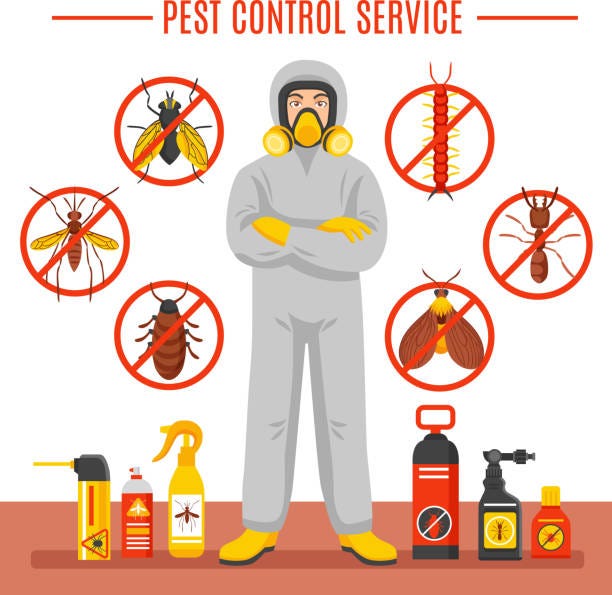High Quality A1 Pest Control Services Charlotte - Safeguard Your Home
High Quality A1 Pest Control Services Charlotte - Safeguard Your Home
Blog Article
Bed Pest Treatment Break Down: Comparing Chemical Vs. Non-Chemical Solutions
In the world of insect control, specifically when managing the relentless problem of bed insects, the option in between chemical and non-chemical therapy options can be a crucial one. Both strategies provide distinct advantages and disadvantages, affecting variables such as effectiveness, safety factors to consider, and general expense. By checking out the nuanced details of each technique, a clearer understanding of which path to pursue in dealing with a bed bug infestation can be acquired.
Effectiveness of Chemical Therapies
Chemical treatments for bed pest invasions have been widely recognized for their rapid and powerful effectiveness in getting rid of these bugs. When taking into consideration the effectiveness of chemical treatments, it is important to understand that they can offer a complete and quick service to a bed bug issue. Professional pest control operators typically count on pesticides to target bed insects at various stages of their life process, including grownups, eggs, and nymphs. These chemicals commonly work by interrupting the bed insects' nerve system, causing paralysis and eventual death.
In addition, chemical treatments have the benefit of supplying residual effects, suggesting that they can remain to eliminate bed insects even after the initial application. This recurring action is especially advantageous in combating any prospective re-infestations. Additionally, the rapid action of chemical treatments can bring alleviation to people facing severe bed insect invasions, permitting them to reclaim control of their living areas quickly.
Safety Interest In Chemical Solutions
When making use of chemical solutions for bed pest treatment is ensuring the safety and security of owners and the setting,One essential element that requires mindful consideration. While chemical therapies can be efficient in removing bed insects, they might pose dangers otherwise dealt with appropriately. One of the main safety and security problems with chemical options is the prospective harm they can cause to human health. Exposure to certain chemicals utilized in bed bug therapies can lead to breathing problems, skin irritation, or other adverse reactions, particularly in people with pre-existing conditions or level of sensitivities. Additionally, incorrect application or dose of chemical pesticides can cause poisonous deposits lingering in the treated area, posing long-lasting health and wellness dangers to occupants.
Moreover, the ecological impact of chemical solutions is another considerable consideration. Some pesticides used in bed pest therapies may be harmful to beneficial pests, wildlife, and communities if they leach into the soil or water systems. It is vital to make use of chemical therapies sensibly, following safety and security guidelines, and thinking about less harmful choices to minimize these threats and make certain the secure and efficient management of bed insect invasions.
Advantages of Non-Chemical Methods
Thinking about the possible safety worries and ecological effect associated with chemical services for bed bug treatment, exploring non-chemical silverfish extermination strategies provides a promising choice with numerous distinctive advantages. Non-chemical therapies are ecologically pleasant, as they do not add to air or water contamination, making them a sustainable option for bug control.
Furthermore, non-chemical options can be reliable in targeting bed insects, consisting of hard-to-reach locations where chemical therapies may not pass through. Methods such as warm treatment, vacuuming, vapor cleaning, and cushion coverings provide thorough elimination without using dangerous chemicals. Moreover, non-chemical methods can be much less turbulent, requiring marginal prep work and permitting quicker reentry into treated areas. In general, going with non-chemical bed insect therapy techniques not just prioritizes safety and security and environmental security however likewise makes sure reliable and comprehensive insect control.
Limitations of Non-Chemical Treatments

Additionally, non-chemical treatments usually require numerous applications to attain successful removal. This can be taxing and might not always ensure total elimination of all bed bugs and their eggs, particularly in covert or hard-to-reach places.
Moreover, the success of non-chemical treatments greatly counts on correct application and thoroughness, which can be testing for individuals without expert expertise. Inadequate application of non-chemical moved here methods might result in insufficient eradication, leading to consistent problems and the demand for added treatments.
As a result, while non-chemical treatments have their benefits, it is vital to recognize these limitations and consider them when figuring out the most effective technique for managing bed pest invasions.
Cost Comparison: Chemical Vs. Non-Chemical Options
Provided the limitations connected with non-chemical therapies, an essential facet to examine in the context of bed bug administration is the expense contrast between chemical and non-chemical choices. In contrast, non-chemical therapies like heat therapy or steam can be extra costly, with costs ranging from $1,000 to $6,000 for a whole home. While the preliminary expense of chemical treatments might seem reduced, several treatments may be called for to totally get rid of the problem, possibly boosting the general expense.
Final Thought

Thinking about the prospective safety concerns and environmental effect connected with chemical remedies for bed pest therapy, checking out non-chemical strategies offers an appealing alternative with a number of unique benefits.Offered the limitations associated with non-chemical treatments, a necessary facet to assess in the context of bed insect monitoring is the price contrast in between chemical and non-chemical options. In comparison, non-chemical treatments like warm treatment or heavy steam can be more costly, with expenses varying from $1,000 to $6,000 for an entire home. While the initial expense of chemical treatments may appear lower, numerous therapies may be needed to fully eradicate the invasion, possibly boosting the total expense.In final thought, when comparing chemical and non-chemical bed bug treatment options, it is necessary to take into consideration performance, safety and security, benefits, limitations, and pest control charges cost.
Report this page